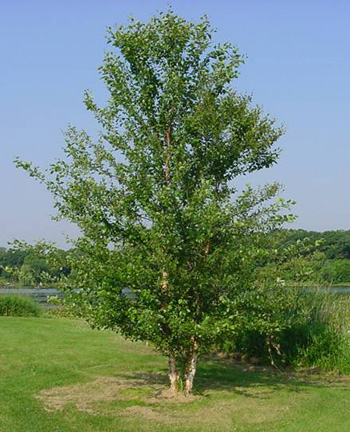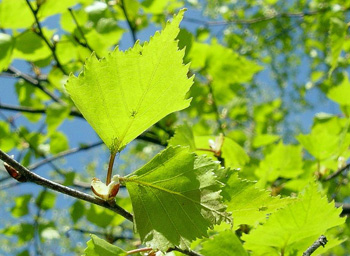Contents:
Common Names | Parts Usually Used | Plant(s) & Culture | Where Found | Medicinal Properties | Biochemical Information
Legends, Myths and Stories | Uses | Formulas or Dosages | How Sold | Warning | Bibliography
Scientific Names

Red Birch
- Betula lenta L.
Black Birch
- Betula nigra L.
- Betulaceae
- Birch family
Common Names
- Black birch
- Cherry birch
- Mahogany birch
- Mountain mahogany
- Red Birch
- Spice birch
- Sweet birch
Parts Usually Used
Inner bark, small twigs, and leaves
Back to Top

Description of Plant(s) and Culture
Black birch is a tree (this is the common birch tree) that grows
Other varieties: marsh birch
Back to Top
Where Found
Found in rich woods; southern Quebec; southwestern Maine to northern Georgia, Alabama, north to eastern Ohio.
Back to Top
Medicinal Properties
Anthelmintic, astringent, diuretic, stimulant, diaphoretic, aromatic
Back to Top
Biochemical Information
Traces of essential oil (methyl salicylate), saponins, tannin, bitter principle, glycosides
Back to Top
Legends, Myths and Stories
The inner bark of both these trees contains an oil which is identical in flavor with the wintergreen plant (Gaultheria procumbens).
In Slavic and Germanic tradition the birch tree was special. It was believed that by being whipped with a birch rod before sunrise on Easter Sunday, a person could barter for health, transferring diseases to the birch branches; witches were said to ride birch brooms at their gathering on the Brocken in the Walpurgis night.
At Pentecost and on Corpus Christi Day, house entrances are decorated with birch branches.
The birch rod is the rod of the saying, “spare the rod and spoil the child”.
Birch rods were used by the schoolmasters of old to correct children. It was used in old Roman days as the bundle of twigs and with axes born in like manner as an ensign, they declared the punishment for lesser, and greater offenses, to the people.
Back to Top
Uses
Leaf tea is used for urinary problems and to expel intestinal worms. Inner bark tea used as mouthwash and taken internally for diarrhea, dysentery, cholera infantum, kidney stones, blood purifier, bowel problems, neuralgia, anti-inflammatory, muscle soreness and pain, gout, scrofula, rheumatism, and externally for sores, boils, canker sores in the mouth. An oil similar to oil of wintergreen can be distilled from the inner bark and twigs. Black birch sap (in springtime) is used for beer makings and flavorings. Used to make root beer. The tea is a pleasant drink in place of water for a time.
Back to Top
Formulas or Dosages
Decoction: use
Tincture: A dose is
Back to Top
How Sold
A type of oil of wintergreen
Back to Top
Warning
Essential oil is toxic. Easily absorbed through the skin. Fatalities reported.
Birch leaves should not be used to treat edema (collections of fluids) resulting from reduced cardiac or renal (kidney) activity.
Back to Top
Bibliography
![]() American Folk Medicine
American Folk Medicine, by Clarence Meyer, Meyerbooks, publisher, PO Box 427, Glenwood, Illinois 60425, 1973
![]() Back to Eden
Back to Eden, by Jethro Kloss; Back to Eden Publishing Co., Loma Linda, CA 92354, Original copyright 1939, revised edition 1994
![]() The Complete Medicinal Herbal
The Complete Medicinal Herbal, by Penelope Ody, Dorling Kindersley, Inc, 232 Madison Avenue, New York, NY 10016, First American Edition, copyright 1993
![]() Culpeper’s Complete Herbal & English Physician: Updated With 117 Modern Herbs
Culpeper’s Complete Herbal & English Physician: Updated With 117 Modern Herbs, by Nicholas Culpeper, Meyerbooks, publisher, PO Box 427, Glenwood, Illinois 60425, 1990, (reprint of 1814)
![]() Eastern/Central Medicinal Plants
Eastern/Central Medicinal Plants, by Steven Foster and James A. Duke., Houghton Mifflin Company, 215 Park Avenue South, New York, NY 10000
 The Healing Plants
The Healing Plants, by Mannfried Pahlow, Barron’s Educational Series, Inc. 250 Wireless Blvd., Hauppauge, NY 11788, 1992
Herbal Recipes, by David C. Meyer, Meyerbooks, publisher, PO Box 427, Glenwood, Illinois 60425, copyright 1978, seventh printing, August 1996
![]() The Herbalist Almanac
The Herbalist Almanac, by Clarence Meyer, Meyerbooks, publisher, PO Box 427, Glenwood, Illinois 60425, copyright 1988, fifth printing, 1994
![]() The Herb Book
The Herb Book, by John Lust, Bantam Books, 666 Fifth Avenue, New York, NY. copyright 1974.
 How Indians Use Wild Plants for Food, Medicine & Crafts
How Indians Use Wild Plants for Food, Medicine & Crafts, by Frances Densmore, Dover Publications, Inc., 180 Varick Street, New York, NY 10014, first printed by the United States Government Printing Office, Washington, in 1928, this Dover edition 1974
![]() Indian Herbalogy of North America
Indian Herbalogy of North America, by Alma R. Hutchens, Shambala Publications, Inc., Horticultural Hall, 300 Massachusetts Avenue, Boston, Massachusetts 02115, 1973
![]() Indian Uses of Native Plants
Indian Uses of Native Plants, by Edith Van Allen Murphey, Meyerbooks, publisher, PO Box 427, Glenwood, Illinois 60425, copyright 1958, print 1990
![]() Planetary Herbology
Planetary Herbology, by Michael Tierra, C.A., N.D., O.M.D., Lotus Press, PO Box 325, Twin Lakes. WI 53181., Copyright 1988, published 1992
![]() The Yoga of Herbs: An Ayurvedic Guide to Herbal Medicine
The Yoga of Herbs: An Ayurvedic Guide to Herbal Medicine, by Dr. David Frawley & Dr. Vasant Lad, Lotus Press, Twin Lakes, Wisconsin, Second edition, 1988.
![]() Webster’s New World Dictionary
Webster’s New World Dictionary, Third College Edition, Victoria Neufeldt, Editor in Chief, New World Dictionaries: A Division of Simon & Schuster, Inc., 15 Columbus Circle, New York, NY 10023
 The Rodale Herb Book: How to Use, Grow, and Buy Nature’s Miracle Plants (An Organic gardening and farming book)
The Rodale Herb Book: How to Use, Grow, and Buy Nature’s Miracle Plants (An Organic gardening and farming book), edited by William H. Hylton, Rodale Press, Inc. Emmaus, PA, 18049., 1974
